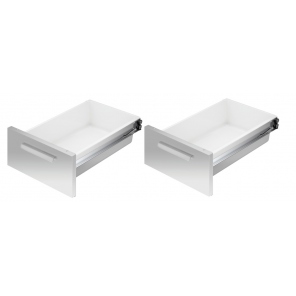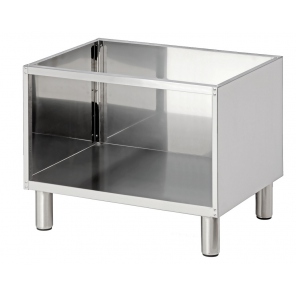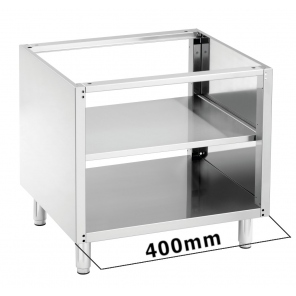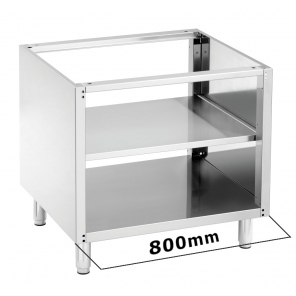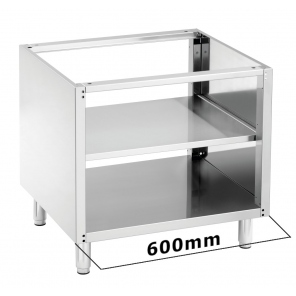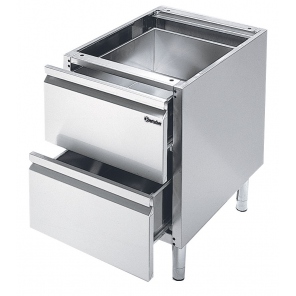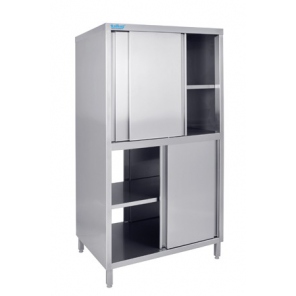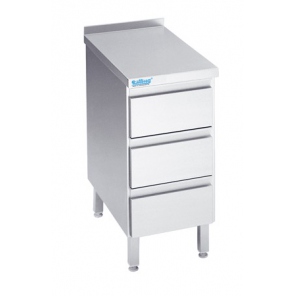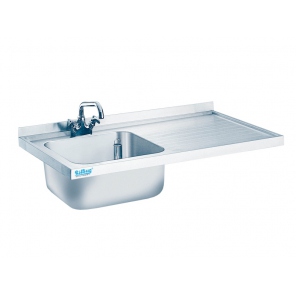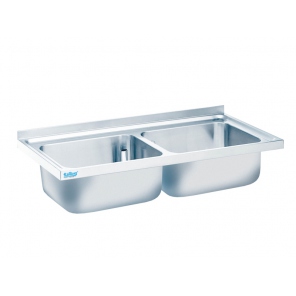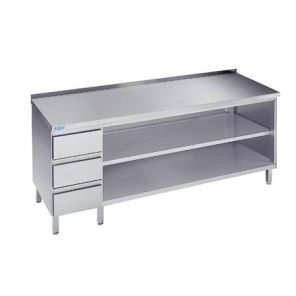Gastronomic Furniture
Gastronomic furniture forms the fundamental equipment of every professional kitchen, restaurant, or catering establishment. These specialized furniture elements are designed for intensive use in commercial environments, meeting strict hygiene and durability standards. Gastronomic furniture differs significantly from household furniture in both construction and materials, ensuring durability and functionality.
Types of Gastronomic Furniture
In professional kitchens, the following main categories of furniture can be distinguished:
- Work tables - basic workstations made of stainless steel, often equipped with lower shelves or drawers
- Gastronomic cabinets - both hanging and standing, used for storing dishes, equipment, and products
- Storage racks - metal constructions that facilitate efficient storage of products and equipment
- Washing stations - single and multi-chamber sinks with draining boards
- Pass-through cabinets - accessible from both sides, often used between preparation and serving areas
- Refrigerated tables - combining a worktop with storage in controlled temperatures
Materials Used in Production
Metal kitchen furniture, particularly stainless steel furniture, dominates professional kitchens due to its key properties:
- Stainless Steel AISI 304 - the primary material for furniture in contact with food:
- Corrosion and mechanical damage resistance
- Easy to maintain cleanliness
- Neutral for food products
- Stainless Steel AISI 430 - used in elements not directly contacting food:
- Lower production cost
- Good resistance to atmospheric factors
- Suitable for structural components
Stainless steel kitchens also use complementary materials:
- Plastic (sealing elements, leveling feet)
- Tempered glass (cabinet doors, display cases)
- Granite and composite (countertops in dessert preparation areas)
- Wood (decorative elements in front areas)
Key Features of Gastronomic Furniture
Professional stainless steel gastronomic furniture must meet several requirements to ensure its suitability for intensive commercial use:
- Structural durability:
- Load-bearing capacity of worktops: minimum 100 kg/m²
- Reinforced welds and joints
- Stable construction to prevent tipping
- Hygiene safety:
- Smooth surfaces without gaps or recesses
- Rounded corners to prevent dirt accumulation
- Materials approved for food contact
- Functionality:
- Adjustable feet for leveling
- Modular construction allowing expansion
- Integrated drainage systems in washing furniture
Choosing Furniture for Different Kitchen Areas
A professional kitchen is divided into several key areas, each requiring specific equipment:
- Goods receiving area
- Stainless steel transport carts
- High-load capacity storage racks
- Tables with countertops for quality control
- Preliminary preparation area
- Tables with integrated sinks
- Cabinets for tools and small equipment
- Racks for GN containers
- Thermal processing area
- Wall-mounted tables with reinforced structures
- Hanging cabinets with ventilation systems
- Neutral work tables for heavy equipment
- Food serving area
- Heated tables with lamps
- Heated pass-through cabinets
- Serving stations with superstructures
When designing each area, consider:
- Proper communication space (minimum 120 cm)
- Ergonomic arrangement of workstations
- Optimization of product and staff flow
- Ease of maintenance and cleaning
Ergonomics and Functionality
When designing a gastronomic space with stainless steel furniture, special attention should be paid to ergonomic aspects:
- Work surface height:
- Standard countertop height: 85-90 cm
- Precision workstations: 90-95 cm
- Tables for heavy-duty work: 80-85 cm
- Accessibility and organization:
- Full-extension drawer slides
- Adjustable shelves in 50-100 mm increments
- Maximum height of hanging cabinets: 180 cm
Standards and Certifications
Professional gastronomic furniture must meet several standards and possess appropriate certifications:
- Basic certifications:
- PZH approval for food contact materials
- CE compliance declaration
- ISO 9001 certifications for manufacturers
- Industry standards:
- EN 1672-2 concerning hygiene requirements
- PN-EN 1253 for drainage systems
- DIN 18865 for industrial kitchen equipment
Maintenance and Cleaning
Proper care of metal kitchen furniture is crucial for maintaining its durability and hygiene:
- Daily care:
- Cleaning with neutral cleaning agents
- Thoroughly drying surfaces
- Inspecting gaps and joints
- Periodic maintenance:
- Checking joint tightness
- Adjusting hinges and slides
- Inspecting drainage systems
Planning Kitchen Space
Efficient planning of the layout of gastronomic cabinets and other furniture requires considering:
- Basic design principles:
- Work triangle principle
- Minimum communication distances
- Clean and dirty zones
- Technical aspects:
- Access to utilities (water, electricity, gas)
- Ventilation and air conditioning systems
- Floor slopes and drainage systems
Costs and Budgeting
Stainless steel gastronomic furniture represents a significant investment in facility equipment. When planning the budget, consider:
- Cost components:
- Cost of primary materials (30-40% of the price)
- Production and finishing costs (25-35%)
- Transportation and installation costs (10-15%)
- Manufacturer and distributor margins (20-30%)
- Factors affecting price:
- Grade of stainless steel used
- Degree of customization and add-ons
- Order size and delivery time
Top Manufacturers
Leading manufacturers of gastronomic furniture offer comprehensive solutions:
- Criteria for choosing a manufacturer:
- Experience in the gastronomic industry
- Production capacity and machinery
- Portfolio of completed projects
- After-sales service and warranty
Customization of Gastronomic Furniture
Customization of metal kitchen furniture allows for optimal adaptation to the needs of a specific establishment:
- Modification options:
- Dimensions and element configuration
- Additional equipment and accessories
- Surface finish type
- Popular custom solutions:
- Integrated power systems
- Non-standard storage systems
- Special mounting solutions
Gastronomic Furniture and Sanitary Regulations
Compliance with sanitary requirements is crucial for stainless steel furniture used in gastronomy:
- Basic requirements:
- Ease of cleaning
- Resistance to disinfectants
- No areas conducive to bacteria growth
- Documentation and controls:
- Hygiene certificates for materials
- Production process documentation
- Sanitary inspection protocols
Technological Innovations
Modern gastronomic furniture incorporates advanced technological solutions to enhance functionality:
- Smart systems:
- Electronic temperature control systems
- Automatic ventilation systems in cabinets
- Integrated humidity sensors
- Advanced materials:
- Antibacterial coatings on work surfaces
- Self-cleaning coatings
- Composite materials with enhanced durability
Comparison: Ready-Made Sets vs. Custom Furniture
The choice between standard and customized stainless steel gastronomic furniture depends on several factors:
- Ready-made sets:
- Advantages:
- Lower purchase cost
- Quick availability
- Proven solutions
- Disadvantages:
- Limited size flexibility
- Standard equipment
- Potential fit issues
- Custom furniture:
- Advantages:
- Perfect fit for the space
- Personalized solutions
- Possibility of integrating special functions
- Disadvantages:
- Higher cost
- Longer production time
- Requires precise planning
How to Make the Right Choice?
When choosing metal kitchen furniture, consider the following criteria:
- Needs analysis:
- Defining the specifics of the operation
- Expected intensity of use
- Sanitary and industry requirements
- Practical aspects:
- Available budget and schedule
- Space adaptation possibilities
- Business development prospects
- Recommended steps:
- Consultation with an experienced designer
- Comparison of offers from different manufacturers
- Checking references and projects
- Analysis of warranty and service conditions












































